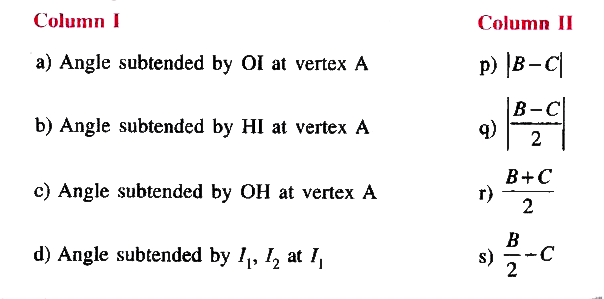Through the centroid of an equilateral triangle, A line parallel to the base is drawn. On this line an arbitrary point P is taken inside the triangle. Let h denote the distance of P from the base, are distances from other two sides then Solution in Telugu
The correct Answer is:a
Step by step video, text & image solution for Through the centroid of an equilateral triangle, A line parallel to the base is drawn. On this line an arbitrary point P is taken inside the triangle. Let h denote the bot^("lar") distance of P from the base, h_1 h_2 are bot^("lar") distances from other two sides then by Maths experts to help you in doubts & scoring excellent marks in Class 11 exams.
Updated on:21/07/2023Topper's Solved these Questions
- PROPERTIES OF TRIANGLESBOOK - AAKASH SERIESCHAPTER - PROPERTIES OF TRIANGLESEXERCISE - LECTURE SHEET EXERCISE - IV (More than one correct answer Type Questions)
3 Videos
- PROPERTIES OF TRIANGLESBOOK - AAKASH SERIESCHAPTER - PROPERTIES OF TRIANGLESEXERCISE - LECTURE SHEET EXERCISE - IV (Matrix Matching Type Questions)
2 Videos
- PROPERTIES OF TRIANGLESBOOK - AAKASH SERIESCHAPTER - PROPERTIES OF TRIANGLESEXERCISE - LECTURE SHEET EXERCISE - III (Straight Objective Type Question)
62 Videos
- PLANESBOOK - AAKASH SERIESCHAPTER - PLANESEXERCISE - ADVANCED SUBJECTIVE TYPE QUESTIONS
30 Videos
- PROPERTIES OF VECTORSBOOK - AAKASH SERIESCHAPTER - PROPERTIES OF VECTORSEXERCISE - PRACTICE EXERCISES
55 Videos
Similar Questions
If I is incentre of the triangle ABC,P1,P2,P3 are radii of circum circles of ΔleIBC,ICA,IAB respectively
View Solution
View SolutionIn a triangle if r1=2r2=3r3, then ab+bc+ca=
View SolutionThe plane 2x + 3y + kz - 7 = 0 is parallel to the line whose d.r's are (2,-3,1) then k=
View SolutionIf ¯¯¯¯¯¯OA=¯i+2¯j−3¯k,¯¯¯¯¯¯OB=3¯i−2¯j+5¯kand2¯¯¯¯¯¯AC=3¯¯¯¯¯¯AB then ¯¯¯¯¯¯AC=
View SolutionThrough the centriod of an equilateral triangle a line parallel to the base is drawn. On this line, an arbitary point P is taken inside the triangle. Let h denote the distahce of P from the base of the triangle. Let h1andh2 be the distance of P from the other two sides of the triangle, then
View SolutionThe distance between the two parallel lines is 1 unit. A point A is chosen to lie between the lines at a distance 'd' from one of them Triangle ABC is equilateral with B on one line and C on the other parallel line. The length of the side of the equilateral triangle is
View SolutionThrough the centroid of an equilateral triangle, a line parallel to the base is drawn. On this line, an arbitrary point P is taken inside the triangle. Let h denote the perpendicular distance of P from the base of the triangle. Let h1andh2 be the perpendicular distance of P from the other two sides of the triangle . Then :
View SolutionA point P is inside an equilateral triangle if the distance of P from sides 8,10,12 then the length of the side of the triangle is
View SolutionThere is a point inside an equilateral triangle ABC of side a whose distance from the vertices is 3,4,5 . Rotate the triangle and P through 60∘ about C. Let A go to A' and P to P'.
The area of traingle PAP' is
View SolutionThere is a point inside an equilateral triangle ABC of side d whose distance from the vertices is 3,4,5 . Rotate the triangle and P through 60∘ about C. Let A go to A' and P to P'.
The angle APB is equal to
View SolutionThere is a point inside an equilateral triangle ABC of side d whose distance from the vertices is 3,4,5 . Rotate the triangle and P through 60∘ about C. Let A go to A' and P to P'.
The value of d2 is
View SolutionABC is an equilateral triangle such that the vertices B and C lie on two parallel lines at a distance 6. If A lies between the parallel lines at a distance 4 from one of them, then the length of a side of the equilateral triangle is :
View SolutionLet the point P lies in the interior of an equilateral triangle with side lengths 2 units, each. Find the sum of the shortest distances from P to the sides of the triangle.
View SolutionEquilateral triangle DEF is inscribed in equilateral triangle ABC as shown with DE⊥larBC then ratio of Area of triangle DEF to the Area of ΔleABC is then
View Solution
